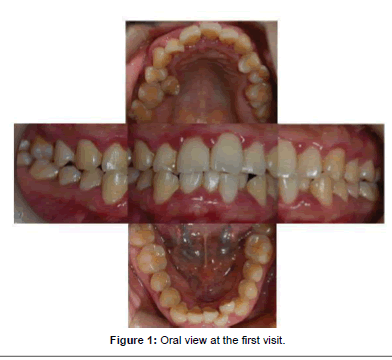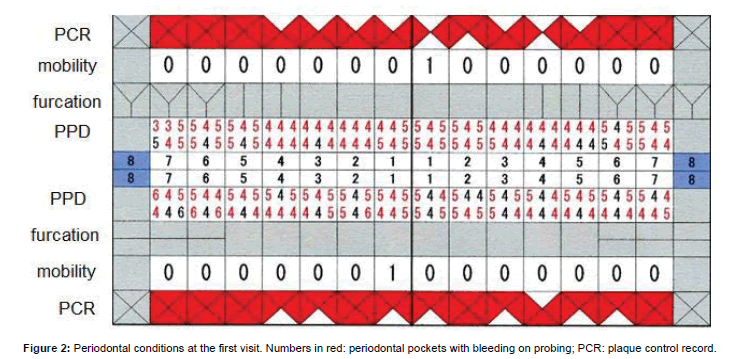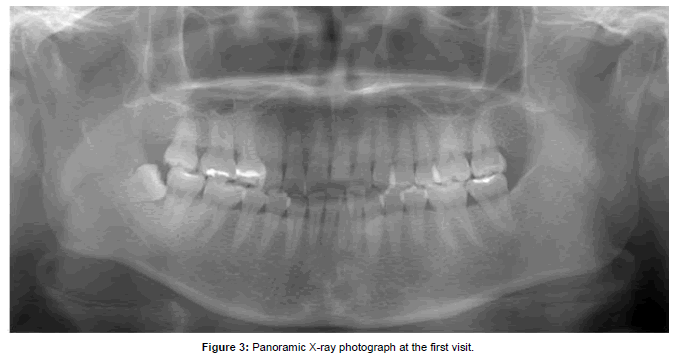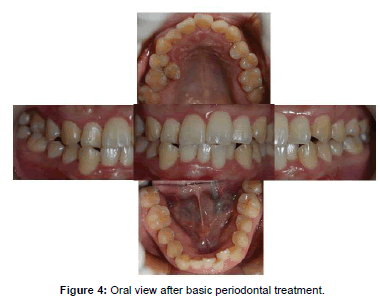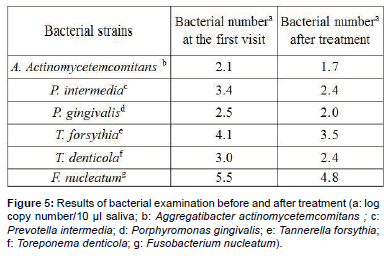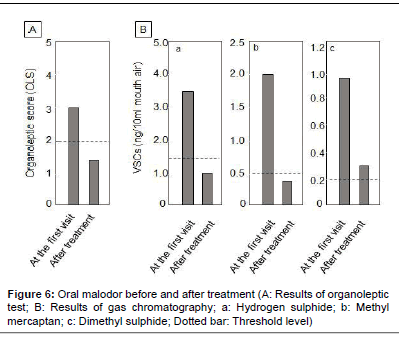Case Report Open Access
A Case of Oral Malodor: Improving the Motivation of Patients by Use of Bacterial Examination
Yoneda M1*, Suzuki N2, Fujimoto A1, Ishii A3, Yamada K1, Masuo Y1, Iwamoto T4, Haraga M5and Koga C5 Morita H1, Inoue Y3, and Hirofuji T1
1Department of General Dentistry, Fukuoka Dental College, Japan
2Department of Preventive and Public Health, Fukuoka Dental College, Japan
3Department of Dental Hygiene, Fukuoka College of Health Science, Japan
44Yayoigaoka Solare Dental, Japan
5Centre for Oral Diseases, Fukuoka Dental College, Japan
- *Corresponding Author:
- Masahiro Yoneda
Section of General Dentistry
Department of General Dentistry
Fukuoka Dental College, 2-15-1
Tamura, Sawara-ku, Fukuoka 814-0193, Japan
Tel: +81-92-801-0411 (Ext) 125
Fax: +81- 92-801-4909
E-mail: yoneda@college.fdcnet.ac.jp
Received date April 11, 2016; Accepted date May 02, 2016; Published date May 09, 2016
Citation: Yoneda M, Suzuki N, Fujimoto A, Ishii A, Yamada K (2016) A Case of Oral Malodor: Improving the Motivation of Patients by Use of Bacterial Examination. J Oral Hyg Health 4:200. doi: 10.4172/2332-0702.1000203
Copyright: © 2016 Yoneda M, et al. This is an open-access article distributed under the terms of the Creative Commons Attribution License, which permits unrestricted use, distribution, and reproduction in any medium, provided the original author and source are credited.
Visit for more related articles at Journal of Oral Hygiene & Health
Abstract
Here, we report a case of oral malodor that was diagnosed by bacterial examination. The patient (a 32-year-old female) visited our breath clinic because a family member advised her to do so. Strong oral malodor was detected by several tests including an organoleptic test, a portable sulfide monitor, and gas chromatography. She noticed her oral malodor, but her motivation toward treatment was low. Even after explaining the cause of halitosis and the importance of oral hygiene, her motivation did not improve. So we applied a bacterial examination, and explained the results in detail. She understood how oral bacteria had caused the oral malodor, and she tried to do tooth brushing better. After a basic periodontal treatment, her oral condition improved and the number of periodontopathic bacteria reduced. She continued with careful tooth brushing even after the periodontal treatment, and her breath odor remarkably decreased. This case report indicates the usefulness of bacterial examination for motivating patients to improve their oral hygiene.
Keywords
Oral malodor; Motivation; Bacterial examination; Oral hygiene
Introduction
Oral malodor is one of the major oral problems these days [1]. The major source of bad breath is volatile sulfur compounds (VSCs) [2,3]. VSCs are produced mainly by bacteria in the periodontal pockets or tongue coating [4]. Oral malodor usually decreases after proper oral hygiene or periodontal treatment. But if a patient does not have a high motivation toward treatment, the oral condition will not improve and oral malodor may not decrease. The patient in this case report did not have a high motivation, and our regular instruction could not change her consciousness at first. But when we applied a bacterial test and explained the results of the test, her motivation remarkably increased, and her oral malodor was decreased. In this case report, the results of the treatment procedures are reported.
Case Report
A 32-year-old female attended our hospital complaining of oral malodor. She did not come to our hospital by her own will, but her family members advised her to do so.
The severity of oral malodour in this patient was determined using an organoleptic test [5], portable sulphide monitoring (MSHalimeter E®; Interscan Corporation, Chatsworth, CA, USA) [6] and gas chromatography (model GC14B; Shimadzu Works, Kyoto, Japan) as described before [7,8]. The organoleptic score was 4 (tolerable bad smell) according to the classification [9,10], and all the VSCs such as hydrogen sulfide, methyl mercaptan and dimethyl sulfide were above the positive level.
We performed an oral examination to identify the causes of her oral malodor. As shown in Figure 1, the gum exhibited swelling with inflammation. The pocket depths were 6 mm at the deepest site, and almost all pockets had bleeding on probing (Figure 2). However, the alveolar bone resorption was not so severe (Figure 3). Our diagnosis was a genuine halitosis associated with periodontal inflammation [9,10]. She actually noticed her oral malodor, but she did not understand the cause of oral malodor or the importance of oral hygiene. We explained the causes of oral malodor and the importance of oral hygiene as usual. But she did not have a high motivation, and the oral hygiene condition did not improve. We collected her saliva and performed a bacterial test (Saliva Check Lab, GC Corporation, Tokyo, Japan). Some periodontopathic bacteria were detected at a high level, and we explained her oral condition and the cause of oral malodor. We also showed a picture of the bacteria and explained how these bacteria affect periodontal tissues and result in bad breath. The patient improved her oral hygiene practice and her plaque control record was changed from 80% to below 20%.
We performed basic periodontal treatment including scaling and root planing. The inflammation of gum was reduced (Figure 4) and the periodontal condition was improved. Percentage of bleeding-onprobing sites at the first visit was 98.8%, but it reduced to 3.0% after treatment. The percentage of pockets more than 4 mm was changed from 82.7% to 8.9%. We examined the oral bacterial level again, and the number of periodonto pathogens was found to be reduced (Figure 5). Her motivation toward treatment was further improved. She performed tooth brushing more frequently, and the periodontal condition further improved (data not shown). Seven months after the first visit, we examined the patient’s breath odor again. The results of all the halitosis tests including the organoleptic test, the Halimeter test, and gas chromatography were reduced to almost below the detectable level (Figure 6).
Discussion
Oral malodor is associated primarily with the condition of the oral cavity, including the oral hygiene level and periodontal condition [4,6,11], and is mainly the result of the microbial metabolism of amino acids in local debris [12].
The patient in this report noticed her oral malodor because her family members pointed it out. She herself did not worry about her bad breath so much, but she actually had a strong breath odor. We explained the oral condition and the importance of oral hygiene, but the patient’s motivation to improve her oral hygiene did not improve. But, with the use of a bacterial test, she understood the importance of oral hygiene and her tooth brushing was improved. After treatment, the patient’s oral condition improved and the number of periodontopathic bacteria reduced. Even after finishing active periodontal treatment, she was highly motivated to reduce the number of periodontopathic bacteria, and she performed good oral hygiene, which resulted in a low breath odor.
There are many type of halitosis, and we reported several halitosis cases [13]. It is not difficult to reduce oral malodor if we find the causes of malodor. We sometimes encounter cases in which the patient has a low motivation for treatment, and we need to apply various methods to improve the patient’s motivation [14]. From the result of this case, bacterial examination is considered to be one of the effective methods. However, we need to emphasize two points to avoid misunderstanding. First, we need to accumulate evidence with more cases to reveal the effectiveness of bacterial examination. Second, the most important point is to accurately measure the level of oral malodor, and the bacterial test in this case was applied to improve patient’s motivation.
Acknowledgements
This study was in part supported by Grant-in-Aid for Scientific Research (C) 16K11577 (M.Y) and Grants-in-Aid for Advanced Science Research (M.Y, T.H) from the Ministry of Education, Culture, Sports, Science, and Technology, Japan.
References
- Miyazaki H, Sakao S, Katoh Y, Takehara T (1995) Oral malodor in the general population of Japan. In Bad breath: Research perspectives (Rosenberg M, 2ndedn) Ramot publishing-Tel Aviv University. Tel Aviv 119-136.
- Tonzetich J (1971) Direct gas chromatographic analysis of sulphur compounds in mouth air in man.Arch Oral Biol 16: 587-597.
- Kleinberg I,Westbay G (1990) Oral malodor.Crit Rev Oral Biol Med 1: 247-259.
- Suzuki N,YonedaM,Hirofuji T (2015) Evidence-based control of oral malodor in the book “Emerging trends in oral health sciences and dentistry”, In Tech, Croatia, Europe.
- Lee SS, Zhang W, Li Y (2007) Halitosis update: a review of causes, diagnoses, and treatments.J Calif Dent Assoc 35: 258-260 .
- Rosenberg M,Kulkarni GV, Bosy A, McCulloch CA (1991) Reproducibility and sensitivity of oral malodor measurements with a portable sulphide monitor.J Dent Res 70: 1436-1440.
- Furne J,Majerus G, Lenton P, Springfield J, Levitt DG, et al. (2002) Comparison of volatile sulfur compound concentrations measured with a sulfide detector vs. gas chromatography.J Dent Res 81: 140-143.
- Yoneda M, Suzuki N and Hirofuji T (2015) Current status of the techniques used for halitosis analysis. Austin Chromatogr 2: 1-3.
- Miyazaki H, Arao M, Okamura K, Kawaguchi Y, Toyofuku A et al (1999) Tentative classification for halitosis patients and its treatment needs. Niigata Dent J 32: 11-15.
- Yaegaki K, Coil JM (2000) Examination, classification, and treatment of halitosis; clinical perspectives.J Can Dent Assoc 66: 257-261.
- Delanghe G, Ghyselen J, Feenstra L, van Steenberghe D (1996) Experiences of Belgian multidisciplinary breath odor clinic. ActaOtorhinolaryngolBelg 51: 43-48.
- Scully C, Porter S, Greenman J (1994) What to do about halitosis.BMJ 308: 217-218.
- Yoneda M, Suzuki N, Macedo SM, Fujimoto A, Iha K et al. (2012) The variable etiology of oral pathologic halitosis: a case series. Smile Dent Journal 7: 50-56.
- Dumitrescu AL,Wagle M, Dogaru BC, Manolescu B (2011) Modeling the theory of planned behavior for intention to improve oral health behaviors: the impact of attitudes, knowledge, and current behavior.J Oral Sci 53: 369-377.
Relevant Topics
- Advanced Bleeding Gums
- Advanced Receeding Gums
- Bleeding Gums
- Children’s Oral Health
- Coronal Fracture
- Dental Anestheia and Sedation
- Dental Plaque
- Dental Radiology
- Dentistry and Diabetes
- Fluoride Treatments
- Gum Cancer
- Gum Infection
- Occlusal Splint
- Oral and Maxillofacial Pathology
- Oral Hygiene
- Oral Hygiene Blogs
- Oral Hygiene Case Reports
- Oral Hygiene Practice
- Oral Leukoplakia
- Oral Microbiome
- Oral Rehydration
- Oral Surgery Special Issue
- Orthodontistry
- Periodontal Disease Management
- Periodontistry
- Root Canal Treatment
- Tele-Dentistry
Recommended Journals
Article Tools
Article Usage
- Total views: 12969
- [From(publication date):
May-2016 - Apr 07, 2025] - Breakdown by view type
- HTML page views : 12043
- PDF downloads : 926

